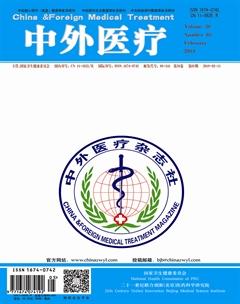心尖肥厚型心肌病患者的心律失常特点研究
秦淑娟
[摘要] 目的 從生化指标表达、超声心动图表现及预后3方面分析心尖肥厚型心肌病患者合并发生心律失常后的特点。 方法 方便选取2013年4月—2015年10月期间北京阜外医院/成都市第三人民医院收治的87例心尖肥厚型心肌病患者作为研究对象,根据是否合并心律失常将87例患者分为观察组(合并心律失常)和对照组(未合并心律失常),收集两组患者生化指标检测结果、超声心动图检查结果、临床治疗及预后资料,进行数据统计分析,从上述3个方面总结心尖肥厚型心肌病患者的心律失常特点。 结果 观察组合并心律失常的类型包括心房扑动、窦性心动过缓、心房颤动、室性心律失常、房室传导阻滞。生化指标,观察组患者的TG为(1.53±0.35)mmol/L,低于对照组的为(2.30±0.39)mmol/L(t=6.571;P<0.05),NT-pro BNP为(2.93±0.35)pmol/L,高于对照组的(2.26±0.41)pmol/L(t=5.558;P<0.05),其他生化指标检测结果比较差异无统计学意义(P>0.05)。超声心动图检查结果,观察组中心律失常组类型为心房颤动的患者左心房前后径为(40.05±5.02)mm,大于对照组患者的(34.91±4.88)mm(t=3.283;P<0.05)。其他参数比较差异无统计学意义(P>0.05)。观察组患者随访期间的心脏不良事件发生率为8.16%、死亡率为4.08%,与对照组患者的5.26%、2.63%比较差异无统计学意义(χ2=0.713、0.135,P>0.05)。 结论 心律失常作为心尖肥厚型心肌病患者的常见临床表现,类型较多,包括心房扑动、窦性心动过缓、室性心律失常等,但合并发生后并不会出现较多特异性表现,对患者预后无明显影响。
[关键词] 心尖肥厚型心肌病;超声心动图;生化指标
[中图分类号] R542.2 [文献标识码] A [文章编号] 1674-0742(2019)02(b)-0025-03
Arrhythmia Characteristics in Patients with Apical Hypertrophic Cardiomyopathy
QIN Shu-juan
Institute of Cardiovascular Diseases, Chengdu Third People's Hospital, Chengdu, Sichuan Province, 610031 China
[Abstract] Objective To analyze the characteristics of arrhythmia patients with apical hypertrophic cardiomyopathy after biochemical index expression, echocardiographic findings and prognosis. Methods From April 2013 to October 2015, 87 patients with apical hypertrophic cardiomyopathy admitted to Beijing Fuwai Hospital/Chengdu Third People's Hospital were convenient included in the study. 87 patients were divided into observation group according to whether or not they had arrhythmia combined arrhythmia and control group (without arrhythmia), biochemical indicators, echocardiography, clinical treatment and prognosis data were collected from two groups, and statistical analysis was performed. The apical hypertrophic myocardium was summarized from the above three aspects. Arrhythmia characteristics of patients. Results The types of combined arrhythmias were observed including atrial flutter, sinus bradycardia, atrial fibrillation, ventricular arrhythmia, and atrioventricular block. The TG of the observation group was (1.53±0.35) mmol/L, which was lower than that of the control group (2.30±0.39) mmol/L (t=6.571; P<0.05), and NT-pro BNP was (2.93±0.35) pmol/L, which was higher than that of the control group (2.26±0.41) pmol/L (t=5.558; P<0.05). There was no significant difference between the other biochemical indicators (P>0.05). According to the results of echocardiography, the left atrial anteroposterior diameter of the patients with atrial fibrillation in the observation group was (40.05±5.02) mm, which was greater than that of the control group (34.91±4.88) mm (t=3.283; P<0.05). There were no significant differences in other parameters (P>0.05). The incidence of cardiac adverse events during the follow-up period was 8.16% and the mortality rate was 4.08%. There was no significant difference between the control group of (5.26%, 2.63%) (χ2=0.713, 0.135, P>0.05). Conclusion Arrhythmia is a common clinical manifestation of patients with apical hypertrophic cardiomyopathy. There are many types, including atrial flutter, sinus bradycardia, ventricular arrhythmia, etc., but there will be no more specific manifestations after the merger. There is no significant effect on the prognosis of patients.

